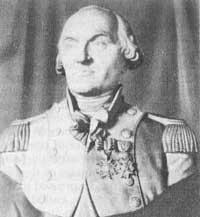Charles Augustin Coulomb
French physicist who entered Angulema on June 14, 1736. As a young man he joined the Army as an engineer and was sent to work at his request to the West Indies (Martinique Island). There he worked for nine years in the construction of the fort called Fort Bourbon.
He returned from the Indies and left the army. By then he had a fondness for science within him and began to experiment. When the French Revolution broke out, he decided to retire to the village of Blois to continue working there. His withdrawal in politics allowed him to spend a little quiet on the Terror of the Revolution.

By then he was famous as a scientist. In 1777 he published on the one hand his first work entitled “Studies for the optimal manufacture of unbeaten needles”, and on the other hand he invented the torsion scale that same year. This balance measured precisely the force exerted with the twisting that was produced in the thin and rigid fiber. Since weight is the force of gravitation on a body, it could be used to weigh the torsion balance.
The truth is that the English geologist John Michell had already invented a similar balance, but Coulombe did not know and did his work independently. Coulomb used his precision balance in electricity tests. It placed a small electrically charged sphere at different distances in front of another small charged sphere and with its balance measured the force of repulsion or attraction (depending on whether the electric charges were equal or counterposed).
Thus, in 1785 he was able to report his law: the electric force of repulsion or attraction, was directly proportional to the product of the electric charges that had the spheres and inversely proportional to the square of the distance between centers of loads. Coulomb's law therefore means that the forces of electric attraction are similar to those found by Neuwton for gravitation. Since in the atom there are also positive and negative electric charges, the law of Coulomb is of vital importance in its forces of attraction and repulsion.
Priestley, for his part, came to these conclusions a few years earlier and Cavendish also, but Cavendish never published his discoveries and they met fifty years after his death. However, Coulomb published his discoveries in “Mémoires de l’Académie royale des sciences (1785-1789)”.
Coulomb also published in 1779 the work entitled “Theory of simple machines”, in which he analyzed friction problems.
In 1789 he studied the influence of the Earth's magnetic field on the magnetized needle, inventing the concept of magnetic moment and the theory of polarization.
In honor of Coulomb, the electric charging unit is named after him.
Charles Augustin Coulomb died in Paris on 23 August 1806.
Buletina
Bidali zure helbide elektronikoa eta jaso asteroko buletina zure sarrera-ontzian











